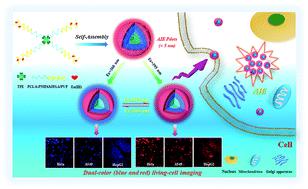当前位置:
X-MOL 学术
›
Mater. Chem. Front.
›
论文详情
Our official English website, www.x-mol.net, welcomes your
feedback! (Note: you will need to create a separate account there.)
A versatile synthetic approach to tunable dual-emissive Pdots with very small-size based on amphiphilic block copolymers for cell imaging
Materials Chemistry Frontiers ( IF 6.0 ) Pub Date : 2020-10-06 , DOI: 10.1039/d0qm00497a Xiaolin Guan 1, 2, 3, 4, 5 , Lin Wang 1, 2, 3, 4, 5 , Meina Liu 1, 2, 3, 4, 5 , Kailong Wang 1, 2, 3, 4, 5 , Xueqin Yang 1, 2, 3, 4, 5 , Yuanyuan Ding 1, 2, 3, 4, 5 , Jinhui Tong 1, 2, 3, 4, 5 , Ziqiang Lei 1, 2, 3, 4, 5 , Shoujun Lai 5, 6, 7, 8
Materials Chemistry Frontiers ( IF 6.0 ) Pub Date : 2020-10-06 , DOI: 10.1039/d0qm00497a Xiaolin Guan 1, 2, 3, 4, 5 , Lin Wang 1, 2, 3, 4, 5 , Meina Liu 1, 2, 3, 4, 5 , Kailong Wang 1, 2, 3, 4, 5 , Xueqin Yang 1, 2, 3, 4, 5 , Yuanyuan Ding 1, 2, 3, 4, 5 , Jinhui Tong 1, 2, 3, 4, 5 , Ziqiang Lei 1, 2, 3, 4, 5 , Shoujun Lai 5, 6, 7, 8
Affiliation

|
Fluorescent polymer dots (Pdots) are a new type of efficient fluorophores with superior optical properties. However, their practical applications in bioimaging and biosensing are being hampered by their potential toxicity, poor water-solubility and the aggregation caused quenching effect. Herein, we report an effective strategy for the preparation of a series of new small-size aggregation-induced emission (AIE) active non-conjugated Pdots, which were self-assembled from three amphiphilic block copolymers, 4s-TPE-PCL-b-PNIPAM-Eu(III) (TPNE), 4s-TPE-PCL-b-PAA-Eu(III) (TPAE) and 4s-TPE-PCL-b-PVP-Eu(III) (TPVE). All of the blocks were synthesized by free-radical polymerization using a macroazoinitiator containing AIE fluorophore tetraphenylethene (TPE), poly(ε-caprolactone) (PCL) segment and azo group, respectively. The obtained TPNE, TPAE and TPVE Pdots had small diameters down to 5 nm and good monodispersity. The Pdots not only exhibited well-separated dual-wavelength emission by 430 and 615 nm upon excitation at 360 and 395 nm, but also displayed thermo-tunable and pH-dependent fluorescence properties, excellent photostability, good water-solubility, good biocompatibility, favorable photoreversibility and noncytotoxicity. More interestingly, the as-prepared three kinds of Pdots displayed reversibly distinct dual-color (blue-red) fluorescence in the targeted three cancer cells (HepG2, A549 and HeLa cells) by merely tuning the excitation wavelength, indicating their potential applications as sensor and multicolour imaging agents in cell biology and diagnostics.
中文翻译:

基于两亲嵌段共聚物的小尺寸可调双发射点的通用合成方法,用于细胞成像
荧光聚合物点(Pdots)是一种新型的高效荧光团,具有出色的光学性能。然而,它们在生物成像和生物传感中的实际应用由于其潜在的毒性,较差的水溶性和聚集引起的猝灭作用而受到阻碍。在此,我们报告了一种有效的策略,该策略可用于制备一系列新型小尺寸聚集诱导发射(AIE)活性非共轭Pdot,它们是由3种两亲嵌段共聚物4s-TPE-PCL- b-自组装而成的- PNIPAM-Eu(III)(TPNE),4s-TPE-PCL- b -PAA-Eu(III)(TPAE)和4s-TPE-PCL- b -PVP-Eu(III)(TPVE)。所有的嵌段都是通过自由基聚合反应而合成的,使用的是一个大偶氮引发剂,该引发剂分别包含AIE荧光团四苯基乙烯(TPE),聚(ε-己内酯)(PCL)段和偶氮基。所得的TPNE,TPAE和TPVE Pdot具有小至5nm的直径和良好的单分散性。这些Pdots在360和395 nm激发时不仅在430 nm和615 nm处显示出分离的双波长发射,而且还显示出热可调和pH依赖的荧光性质,优异的光稳定性,良好的水溶性,良好的生物相容性,良好的光可逆性和非细胞毒性。更有趣的是,所制备的三种Pdots在靶向的三种癌细胞(HepG2,
更新日期:2020-11-03
中文翻译:

基于两亲嵌段共聚物的小尺寸可调双发射点的通用合成方法,用于细胞成像
荧光聚合物点(Pdots)是一种新型的高效荧光团,具有出色的光学性能。然而,它们在生物成像和生物传感中的实际应用由于其潜在的毒性,较差的水溶性和聚集引起的猝灭作用而受到阻碍。在此,我们报告了一种有效的策略,该策略可用于制备一系列新型小尺寸聚集诱导发射(AIE)活性非共轭Pdot,它们是由3种两亲嵌段共聚物4s-TPE-PCL- b-自组装而成的- PNIPAM-Eu(III)(TPNE),4s-TPE-PCL- b -PAA-Eu(III)(TPAE)和4s-TPE-PCL- b -PVP-Eu(III)(TPVE)。所有的嵌段都是通过自由基聚合反应而合成的,使用的是一个大偶氮引发剂,该引发剂分别包含AIE荧光团四苯基乙烯(TPE),聚(ε-己内酯)(PCL)段和偶氮基。所得的TPNE,TPAE和TPVE Pdot具有小至5nm的直径和良好的单分散性。这些Pdots在360和395 nm激发时不仅在430 nm和615 nm处显示出分离的双波长发射,而且还显示出热可调和pH依赖的荧光性质,优异的光稳定性,良好的水溶性,良好的生物相容性,良好的光可逆性和非细胞毒性。更有趣的是,所制备的三种Pdots在靶向的三种癌细胞(HepG2,











































 京公网安备 11010802027423号
京公网安备 11010802027423号